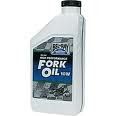Matt Gormley is the copywriting intern here at AltRider, and in his spare time rides his '82 Ironhead Sportster, '74 Kawasaki S3 400 triple, and '76 Yamaha XS 360. Some recent motorcycle maintenance became a learning experience that he shares below.
I had a killer list of tasks to tackle on Friday. So I drank my coffee, walked the dog and headed to the shed.
First on the list was changing the fork oil in my trusty Yamaha XS 360. I had never changed it before, but thought it would be a quick and dirty task, easy enough on a day with lots of chores.
I started by draining all the old fork oil. It looked watery, blown out and clumpy. If I had to wager a guess, I’d say it was probably the original fork oil from the seventies. As I began to work, I realized that popping the fork caps was pretty challenging without an extra set of hands. I also didn't have the center stand installed, which made it tough.
I hunted for my PB Blaster and laid out my tools in the order I would need to grab them. Then I almost took out my eye when the fork cap and spring sprang loose. Oops. I measured out the appropriate amount of fork oil and poured it down the funnel. Getting the fork cap back in place was a bit easier than taking it out. Now I was working smarter, not harder.
I finally got the first fork done in about two hours. Luckily, I planned to tell all my friends it only took about 30 minutes.
The first fork was tough, but this second fork should go lickety split. I wrestled loose the other fork cap after the PB Blaster had a chance to work its magic. I measured out the oil from the BelRay plastic container into the Ratio Rite. My mind was somewhere else, doing who knows what, but I wasn't paying attention at all when I poured the blue oil into the second fork. I finished pouring and my mind did a short double take...
That fork oil is stringy like foam filter oil. F*&%! Oh no!
I noticed the fork oil container next to the foam filter oil container on the bench. Umm... I just filled my fork with foam filter oil.
Suffice to say I had some additional work cut out for me. The second fork took a little longer than the first. And while I did manage to fix my mistake, changing my fork oil ended up being a little more involved than I had planned.
Have you ever made some sort of obvious, oblivious error spinning wrenches? If so, will you share your story so I don’t feel like such a dunce?
Matt
Subscribe to:
Post Comments (Atom)




Ouch, let me count the ways...
ReplyDeleteFirst time I changed my break fluid and tried to bleed the air out of the hose on my 1971 Honda CB750 I forgot to remove the cap seal insert in the fluid reservoir. I got everything else correct, drained the old fluid and attached a tube from the bottom into a jar of new fluid to begin the process of bleeding the air from the break line.
I poured in a couple tablespoons of break fluid and tried to start squeezing the break to move the oil. I stared at the jar waiting for bubbles to start bleeding from the hose. Without realizing the fluid was just sitting in the cap and going nowhere I kept squeezing and squeezing. And squeezing. After about 10 minutes I tried to add more break fluid to the already topped off reservoir and it of course spilled down the handlebar and started eating the paint on the fork crosstrees.
After cursing and cleaning that up I dutifully returned to squeezing the break and staring at the jar waiting for bubbles to emerge. Squeeze, squeeze, squeeze, squeeze over and over and over. I just kept telling myself, "Be patient dude, be ZEN. It'll get there, don't rush it."
I won't say publicly how long I kept that up. When I figured out what the problem was and finally removed the seal it took about two minutes to bleed the line.